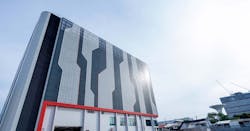New Bangkok Data Center May Tap LNG-fueled District Cooling for On-Site Energy
A new 2-MW data center in the heart of Bangkok’s business district could be powered by regasified liquid natural gas (LNG) to create district cooling energy in its version of a lower-carbon microgrid.
ST Telemedia Global Data Centres (STT GDC) plans to open its Bangkok 3 data center site by the end of this year. It will be the venture’s third data center within the One Bangkok space in the city’s business district.
Through its previous energy supply agreement with PTT Digital Solutions, a wing of Thailand’s state-owned oil and gas entity, STT GDC Thailand could utilize stored "cold energy" from the LNG regasification to supply the data center. The LNG, which is chilled to about minus 162 degrees Celsius (260 Fahrenheit) to liquify natural gas and make it stable for shipping, is then regasified for consumption in the energy process for the data centers and after delivery to the customer.
"STT GDC Thailand is dedicated to building a strong and sustainable digital foundation for Thailand," Supparat Sivapetchranat Singhara na Ayutthaya, CEO of ST Telemedia Global Data Centres (Thailand), said in a statement. "With advanced technology and world-class data centre standards, we are confident that STT Bangkok 3 will meet the needs of the financial sector, e-commerce, start-ups, and various digital service providers, seeking a strategically located site with high-level security standards, flexibility, and unmatched carrier density right from its launch."
Microgrids for Data Centers will key part of content planned for our Conference 2024
Microgrid 2024 in Baltimore: The Call for Speakers is Now Open
The tapping of stored energy within regasified LNG is a fairly new process commercially and largely still under study. In November 2022, PTT and STT GDC signed a memorandum of understanding on jointly studying, designing and undertaking ways of harnessing the cold energy released from regasification of LNG to produce electricity and chilled water for cooling in the data center environment.
At the time, the parties in the MOU by PTT and STT called the concept of “cold energy” as an “untapped resource” for the data center industry. Heating LNG regasifies and releases stored energy to be utilized in district cooling, according to theories on the process.
Data processing facilities worldwide are considered mission critical and almost always have on-site power resources as backup and islandable microgrid-type solutions. These range from diesel and gas-fired gen-sets to renewable and hybrid systems for sustainability goals by the data companies.
“The collaboration with STT GDC Thailand and (the) feasibility study supports this vision as we jointly seek a more sustainable data center industry,” Kaweesak Boonchaleaw, managing director of PTT Digital Solutions, said in the MOU announcement last year. “Moreover, it also reinforces our determination to achieve total carbon neutrality for the PTT Group before 2040.”
Natural gas, made up mainly of methane, is a fossil fuel, but many see it as a bridge to lower greenhouse gas emissions since it emits about half of the carbon dioxide of coal-fired power generation, according to reports. Opponents, such as the National Resources Defense Council, contend that LNG is extremely problematic for the environment as chilling and liquefaction requires high levels of energy use.
Thailand, meanwhile, is making a series of deals to import LNG supply or create closer exploration and production from companies such as Chevron. PTT also reportedly is in advanced talks with Qatar on LNG supply, as well.
The rise of markets for artificial intelligence, machine learning and other data analytic tools is pushing the expansion of data center construction around the world, and the process is very energy intensive. In many cases, the growing data center capacity is not being matched by new and low or carbon-free power installations.
And lack of energy capacity to meet data center demand could impede immediate, responsive growth of technology installations, according to a report by real estate management and investment firm CBRE Group.
“Higher energy costs have also not materially slowed development, but power availability and bottlenecks are challenges,” reads the CBRE report. “Local governments are working to address permitting and planning backlogs on transmission projects, particularly as utility companies aim to connect renewable energy to the grid.”








